Surgical repair of proximal hamstring ruptures reliably improves function
The proximal hamstring is a common location of athletic injuries. Athletes participating in sports that require sprinting, jumping, acceleration and deceleration are at increased risk.
The strongest predictor of recurrent injury is prior hamstring injury. Other risk factors include age, increased body mass index and decreased hip flexor flexibility. The role of hamstring flexibility in prediction and prevention of proximal hamstring injury is controversial, but often regarded as a potential risk factor. Since most proximal hamstring injuries occur early in the athlete’s season, prevention opportunities may exist, especially with an emphasis on eccentric strength training.
One of the most frequently encountered injuries in sports medicine is strain of the proximal hamstring at the myotendinous junction. These may be treated successfully with nonoperative means including compression, limited weight-bearing, modalities and progressive mobilization. Complete, retracted avulsions of the tendinous origin, although less common, are increasing in incidence and are more often surgically treated. Surgical repair of complete acute avulsions results in significantly greater subjective outcomes, rate of return to pre-injury level of sport, and strength and endurance than nonsurgical management. While repair does provide reliable pain relief, good functional outcome, high patient satisfaction and excellent healing rates (via MRI), hamstring strength and return to pre-injury level of sport is not always fully restored.
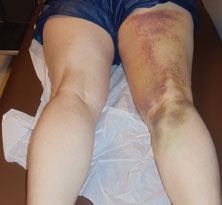
Figure 1. With the patient in the prone position, posterior thigh ecchymosis is seen in this case of proximal hamstring rupture.
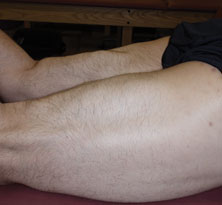
Figure 2. The appearance of chronic proximal hamstring rupture is seen. Similar to "popeye" deformity with biceps brachii rupture in arm, loss of attachment of proximal hamstring origin allows for significant posterior thigh deformity with shortening and bulging.
Images: Harris JD
The purpose of this article is to describe the surgical technique used by the authors to successfully treat both acute and chronic avulsions of the proximal hamstring.
Clinical presentation and diagnosis
Patients who sustain proximal hamstring ruptures typically report an acute injury with sudden pain, muscle spasm and difficulty with ambulation. The mechanism described is usually one of rapid eccentric hamstring contraction (e.g., water-skiing, soccer, falls and bull-riding) with hip flexion and knee extension. Frequently, walking requires a stiff leg to avoid hip or knee flexion that would exacerbate pain. Often noted is the description of the feel or sound of a “pop.” Patients with complete ruptures may present with remarkable amounts of ecchymosis in the posterior thigh, knee and calf (Figure 1). The proximal posterior thigh is tender over a usually-palpable tendinous defect distal to the ischial tuberosity. Best appreciated in the prone position, full knee flexion strength and a “bow-string sign” (palpable tension in distal hamstring tendons) are often absent. Depending upon the degree of swelling, symptoms of sciatic neuropathy may be present due to local compression.
Missed and delayed diagnosis in patients with proximal hamstring avulsion may lead to chronic symptoms necessitating care due to pain, weakness, stiffness, lack of endurance and even significant deformity (Figure 2). These injuries more frequently have muscular spasm, atrophy, deformity and painful sciatica. Patients with chronic complete ruptures who undergo surgical treatment often demonstrate improved outcomes, strength, endurance and return to sport, but not as well as acute repair. Furthermore, the rate of complications and re-rupture is higher with surgery for chronic (vs. acute) avulsions.

Figure 3. Coronal T2-weighted MRI of complete proximal hamstring rupture with large hematoma and tendon retraction is shown.
As with nearly all musculoskeletal injuries, proper imaging work-up begins with plain radiographs. These may demonstrate ischial tuberosity bony avulsions or calcium deposition in the proximal tendon. Advanced imaging includes MRI, which illustrates injury location (number of tendons and retraction), degree of local swelling (hematoma) (Figure 3) and proximity of the sciatic nerve.
Indications
Surgical management is indicated based upon the number of tendons involved, amount of tendon retraction and other patient-related factors (i.e., general medical health and activity levels). If only one tendon is involved or multiple tendons are involved without retraction (<2 cm), non-surgical treatment may be successful. Patients with desires to return to full activity and multi-tendon injury with greater than 2 cm of retraction merit consideration for surgical repair. Although less successful and less predictable, surgical repair in the chronic setting also may be warranted but may require sciatic neurolysis and augmentation of the repair with allograft.
The hamstring musculature is comprised of the biceps femoris (long and short heads), semimembranosus and semitendinosus. The “footprint” for the proximal origin is large, approximately 3 cm wide and long, on the inferolateral aspect of the ischial tuberosity. The long head biceps and semitendinosus form a conjoint tendon on the lateral ischial tuberosity, while the semimembranosus origin is just medial. The sciatic nerve is located lateral to the proximal hamstring origin, entering the surgical field under the piriformis into the posterior thigh. The posterior femoral cutaneous nerve also traverses under the piriformis into the posterior thigh, beneath gluteus maximus to run deep to the gluteal fascia and fascia lata over the long head of biceps femoris.
Surgical description
Under general anesthesia, the patient is positioned on the operative table prone, with the break in the table flexed at the pelvis, to allow for the ischial tuberosity to rotate into the surgical field. Although a longitudinal or transverse skin incision may be used, a transverse incision in the gluteal fold provides sufficient exposure with excellent cosmesis in the acute scenario (Figure 4). Even with extensive tendon retraction acutely, sufficient skin mobility allows for tendon excursion and re-approximation to the tuberosity. The tendon defect is usually palpable and allows for accurate incision placement. Care must be taken to avoid the posterior femoral cutaneous nerve and its branches. The gluteal fascia is incised, and the inferior free border of gluteus maximus is retracted proximally using a blunt retractor, exposing the deep thigh fascia over the proximal hamstring. Gluteus maximus may be split in line with its fibers if the inferior free edge projects distally enough to preclude satisfactory visualization of the tuberosity. However, avoid excessive dissection to preserve the superior gluteal nerve.
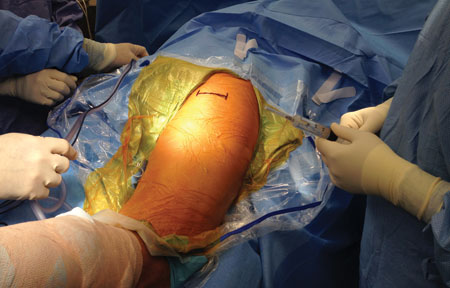
Figure 4. The location of the transverse skin incision in the gluteal fold can be seen.
The deep fascia is incised longitudinally, often with expression of a large hematoma, exposing the avulsed tendon stump and ischial tuberosity. A pseudocapsule with hematoma may be encountered acutely, while extensive scar tissue may be encountered in the chronic situation. In either situation, the sciatic nerve is identified deep and lateral to the proximal tendon and should be protected at all times. The tendon is identified, mobilized and prepared for suturing (Figure 5). Any remaining tendon stump is curetted off the inferolateral ischium, creating a bony bleeding surface for healing. Multiple suture anchors (usually two or three) are placed in the lateral ischium. Place only one limb of each suture (via Krackow technique) in the tendon to allow for a “pulley technique,” reducing the tendon to the anatomic footprint (Figure 6).
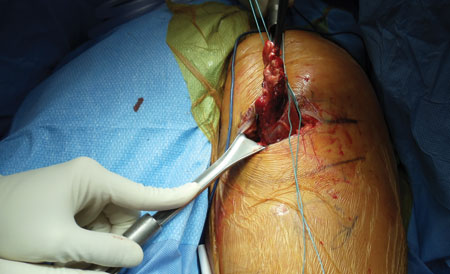
Figure 5. The proximal hamstring tendon end is identified, mobilized and prepared for suturing.
In the setting of chronic tendon rupture, a longitudinal skin incision is required to facilitate tendon exposure and mobilization, adhesiolysis and sciatic neurolysis. Although removal of tendinous fibrous scar is warranted, take care to avoid excessive iatrogenic shortening. Tendon and bony preparation and re-attachment are accomplished similar to acute injuries provided that the tendon can be mobilized to the ischial tuberosity. Depending on the chronicity of the injury, the hamstring muscle may be scarred to the sciatic nerve and requires careful dissection, neurolysis and mobilization of the hamstring to bring the tendon back to its anatomical insertion. In some cases, the tendon may not be mobilized to the ischium or may be under tension, and the authors prefer to use Achilles allograft to augment the proximal hamstring repair (Figure 7). In a patient with an intact proximal tendon with pain and weakness who has failed conservative treatment, the surgical approach is similar, with debridement of scar tissue and retention of the attached normal tendon.

Figure 6. This diagram illustrates the "pulley technique." One limb of each suture is placed into the tendon, and the other limb is left free. This allows the tendon to be reduced anatomically to the proximal hamstring footprint on the lateral ischium.
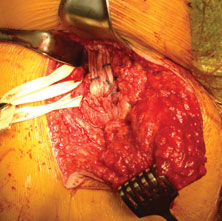
Figure 7. This chronic proximal hamstring rupture required an Achilles tendon allograft reconstruction.
Once secure fixation of the tendon to bone is achieved, the surgical wound is closed in layers. Meticulous hemostasis must be achieved to avoid postoperative hematoma and sciatic nerve compression. Sterile dressing is applied. A hip or knee orthosis may also be applied to prevent undue stress on the repair.
Postoperative rehabilitation
Initial postoperative instructions include toe-touch weight-bearing with crutches and avoidance of positions that could place extreme strain on the repair. These positions are hip flexion and knee extension. Range-of-motion restrictive hip braces that prevent flexion may be used for up to 6 weeks after surgery. If tension is present at the repair site, knee extension may also be limited to 30° to 45° with a hinged knee brace. Active hamstring activity is prohibited. Progression of weight-bearing and gradual re-establishment of hip and knee motion is commenced at 6 weeks postoperatively and may advance over the ensuing 6 weeks. Light concentric hamstring exercises are started at 6 weeks, in conjunction with core and hip stabilization. Active concentric and eccentric strengthening may begin at 3 months, with light jogging, short light sprints and closed chain plyometrics. Return to sport-specific drills and competitive sports may begin at 6 months to 12 months.
Conclusions
Surgical repair of proximal hamstring rupture reliably improves pain and function with excellent patient satisfaction. A recent study at our institution reviewed 15 consecutive patients (mean age 45 years) who underwent repair at mean 3-year follow-up. All 11 patients that participated in sports pre-injury were able to return, however 45% reported a decrease in current level of activity. Isokinetic strength was 78% vs. the contralateral side. Several outcome measures demonstrated significant improvements. This article has described a safe and reproducible surgical technique used to successfully treat this injury.
References:
- Arnason A, Sigurdsson S, Gudmundsson A, et al. Risk factors for injuries in football. Am J Sports Med. 2004;32:5S - 16S.
- Chahal J, Bush-Joseph CA, Chow A, et al. Clinical and magnetic resonance imaging outcomes after surgical repair of complete proximal hamstring ruptures: Does the tendon heal? Am J Sports Med. 2012.
- Cohen S, Bradley J. Acute proximal hamstring rupture. J Am Acad Orthop Surg. 2007;15:350-355.
- Engebretsen A, Myklebust G, Holme I, BahrR. Intrinsic risk factors for hamstring injuries among male soccer players. Am J Sports Med. 2010;38(6):1147-1153.
- Harris JD, Griesser MJ, Best TM, Ellis TJ. Treatment of proximal hamstring ruptures - A systematic review. Int J Sports Med. 2011;32(7):490-495.
- Orava S, Kujala UM. Rupture of the ischial origin of the hamstring muscles. Am J Sports Med. 1995;23(6):702-705.
- Sarimo J, Lempainen L, Mattila K, Orava S. Complete proximal hamstring avulsions: A series of 41 patients with operative treatment. Am J Sports Med. 2008;36(6):1110-1115.
- Witvrouw E, Danneels L, Asselman P, D’Have T, et al. Muscle flexibility as a risk factor for developing muscle injuries in male professional soccer players: A prospective study. Am J Sports Med. 2003;31:41-46.
- Wood DG, Packham I, Trikha SP, Linklater J. Avulsion of the proximal hamstring origin. J Bone Joint Surg Am. 2008;90(11):2365-2374.
For more information:
- Charles A. Bush-Joseph, MD; Joshua D. Harris, MD; and Shane J. Nho, MD, MS, can be reached at Midwest Orthopaedics at Rush, Rush University Medical Center, 1611 West Harrison Street, Chicago, IL 60612. email: joshuaharrismd@gmail.com.
- Disclosures: Bush-Joseph is an unpaid consultant for The Foundry. Harris has no relevant financial disclosures. Nho is a consultant for Stryker, Pivot Medical and Ossur, and receives research support from Stryker, Pivot Medical and Allosource. Institutional Research Support for the study was supplied by Smith & Nephew, Arthrex, Ossur and DePuy Mitek.






